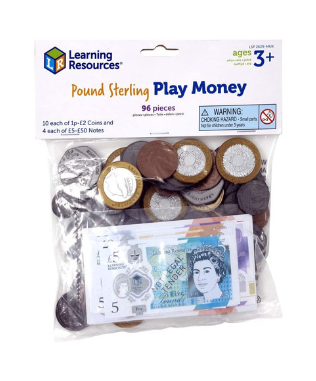A word problem is a written ‘real-life’ scenario where a problem needs to be solved using a mathematical calculation.
Word problems are an important part of learning in the primary curriculum, because they require children to apply their knowledge of various different concepts to ‘real-life’ scenarios, as well as helping them to familiarise themselves with mathematical language.
Resources
- Play Money
- Bath crayons
- Base Ten Set
Method
Nain has 81p. She needs £1. How much more money does she need?
Ioan used the base ten to work out his first question practically.
He then recorded his answer with the bath crayon.
Taid has this much money. How much does he have?
Coins: 20p, 20p, 20p, 10p, 5p, 5p, 2p, 1p, 1p, 1p
Yoshi started off by adding his three twenty pence pieces, then his 10p. I encouraged him to record his working out as he went along.
Next, he he added his two 5ps. Again, I kept reminding him to write down his running total so he didn’t lose track. Ioan’s head is always working a few steps ahead of his hand, which can lead to mistakes in a muti-step question. Recording each step, rather than holding numbers in his head, makes it easier for him to check his working out later.
He added his three 1p coins.
You can see him counting up two more pence under his breath to take him from 83p to 85p.
Nanny wants to buy a cup of tea worth £2. She has this money.
Coins: 10p, 50p, 10p, 2p, 50p, 2p, 50p, 5p, 20p
Does she have enough? Explain your answer.
Ioan read the question and decided on his first step for solving it. He decided to group the coins with other like coins. He put them in order from the largest amount to the smallest.
Once they were in order, Ioan started adding the totals up. He decided to work in pence, rather than mixing units. While recording his three 50ps, he wrote 150 as ‘105’, so I encouraged him to have another go.
He carried on listing his totals for each amount.
Ioan got out the base ten set, to represent each of the numbers that he was going to be adding together.
He added up the total of all the coins, using the base ten. He got out two 100 squares to represent the £2 that Nanny needed to buy her cup of tea. He then lay the amounts of money she had on top, to see if she had enough. I asked him to answer the question and explain his answer.
Part-whole models
The part-whole model is the concept of how numbers can be split into parts. The diagram demonstrates the relationship between a number (whole) and it’s components (parts). This makes it easier to see the building blocks of mathematics and the relationship between addition and subtraction.
For his first component, Ioan worked out how many pounds were in £16.04. He made his £16 out of a £10 note, a £5 note and a £1 coin.
He then made the 4p, for his second component, from two 2p coins.
The part-whole model can be set out in a number of ways. This time there was a blank space for the number at the top, with two of its components given below.
Ioan was trying to explain that this was trickier to work out, because there was only going to be one answer. In the previous example, there could have been more options because any given number can be split into different components.
He worked out the value of the two components.
Then he used that information to fill in his whole number.
How much money is there altogether?
Notes: £50, £20, £10 and £5
His finished tray:









DfES Outcomes for EYFS and National Curriculum (2013)
Numeracy Year 2 programme of study
Measurement
- recognise and use symbols for pounds (£) and pence (p); combine amounts to make a particular value
- find different combinations of coins that equal the same amounts of money
- solve simple problems in a practical context involving addition and subtraction of money of the same unit, including giving change







































